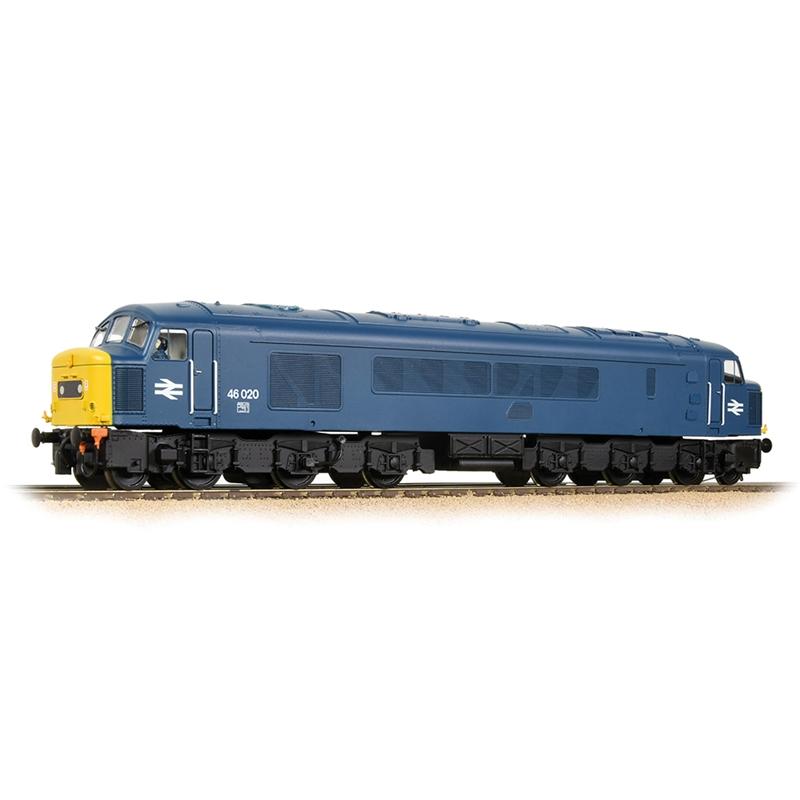BRANCHLINE OO Class 46 Centre Headcode 46020 BR Blue BRANCHLINE
$ 274,99 $ 110,00
BRANCHLINE Class 46 Centre Headcode 46020 BR Blue. OO SCALE.
Highlights:
- Accessory-pack
- Directional lights
History
The Class 46 1Co-Co1 BR-Sulzer Type 4 locos were built from 1961–1963 at British Railways’ Derby Works and were initially numbered D138–D193. With the arrival of TOPS they were renumbered to Class 46. Fifty-six locomotives were built. The first was withdrawn in 1977 and all of them were withdrawn by the end of 1984. Class 46s began their lives with twin headcode panels situated in the centre of the nose, and later built examples a single central headcode panel, to which all class members were progressively converted. The majority received plated over nose ends with sealed beam headlights in the 1970s. Liveries worn were standard BR lined green, ‘austerity’ green without the cream relieveing embellishments of the original livery, and BR Blue with full yellow ends.
The Class 46 design was structurally the same as the preceding Class 45 build, and had the same Sulzer engine, but differed in the fitment of a Brush generator and traction motors, in place of the Crompton Parkinson equipment fitted to the Class 45. Along with the other Sulzer class 44 and 45 designs they are often referred to as “Peaks”, so named because the earliest of the Class 44 were named after mountains.
Despite intermittent use on freight trains, Class 46s were regular performers on passenger turns, particularly North East-South West, Trans-Pennine and secondary North East-London trains, and depot allocations reflected this with locos at Gateshead and Plymouth in 1977 giving a typical spread. Freight workings were also quite often worked over long distances, particularly “clay hoods” carrying china clay from Cornwall to the area around Stoke-on-Trent. In the 1980s the remaining locomotives were concentrated at Gateshead depot, and the final booked passenger workings for the class were the dated summer Saturday services Bradford – Weymouth (between Bradford and Birmingham New Street), Newcastle – Plymouth, Newcastle – Blackpool North, and York – Blackpool North. The Class 46s also worked several named expresses including the Yorkshire Pullman, Flying Scotsman, Hull Executive, Thames-Clyde and Thames-Forth, also known as The Waverley, on the much lamented route from Carlisle to Edinburgh via Hawick.
| Title | Default |
|---|
Quick Shipping and Professional Packaging
Due to our long-term partnership in a long-standing partnership with UPS, FedEx, DHL and many other leading global carriers, we are able to offer an array of shipping options. Our warehouse staff are highly trained and will pack your products according to our precise and precise specifications. Your items will undergo a thorough inspection and be securely secured prior to being delivered. We ship to thousands clients each day across multiple countries. This is an indication of our dedication to being the biggest online retailer in the world. The warehouses are located in Europe as much as they are in the USA.
Note: Orders that include more than one item are assigned a processing time in accordance with the item.
Prior to shipment before shipping, we'll inspect thoroughly the items you've ordered. The majority of orders are shipped within 48 hrs. The time to deliver varies from 3-7 days.
Returns
We don't manage the stock in our warehouse and factory. Stocks are subject to change at any moment. You may not receive your order after the order has been made.
Our policy is for 30 days. If you have passed 30 days by since your purchase, unfortunately we can't offer you a refund or exchange.
The item cannot be used and in its original condition. It should also be in the original packaging.
Related products
RADIO CONTROL
RADIO CONTROL
RADIO CONTROL
RADIO CONTROL
RADIO CONTROL
RADIO CONTROL
(Clearance Item) HB RACING 5 Cell Main Chassis 2.5mm with Battery Tray (Cyclone) HB RACING
RADIO CONTROL
RADIO CONTROL
RADIO CONTROL


































